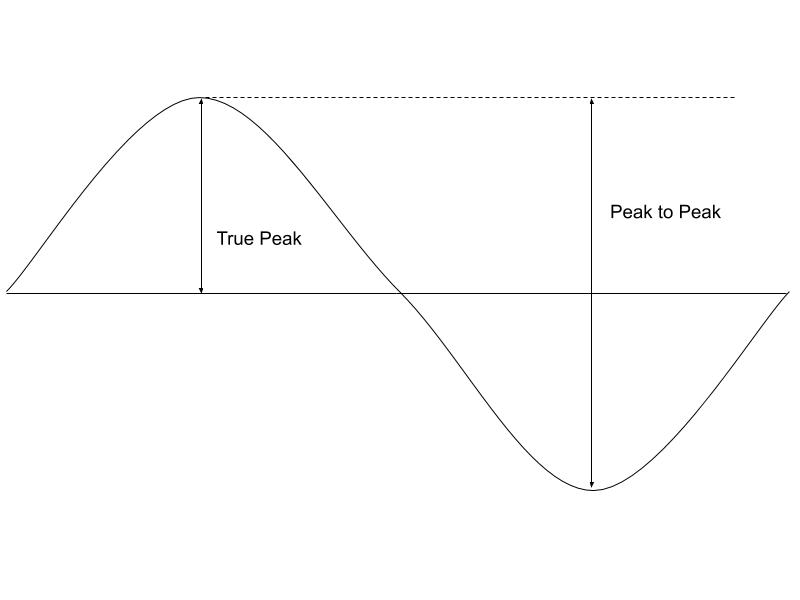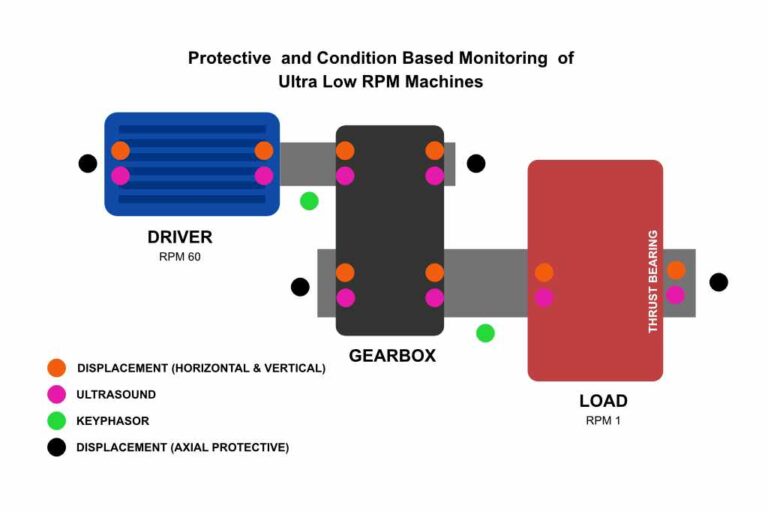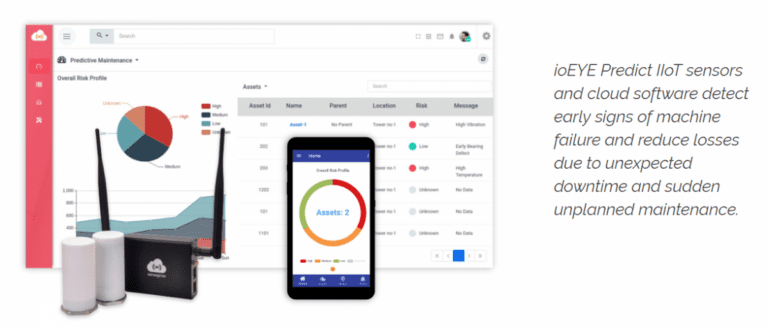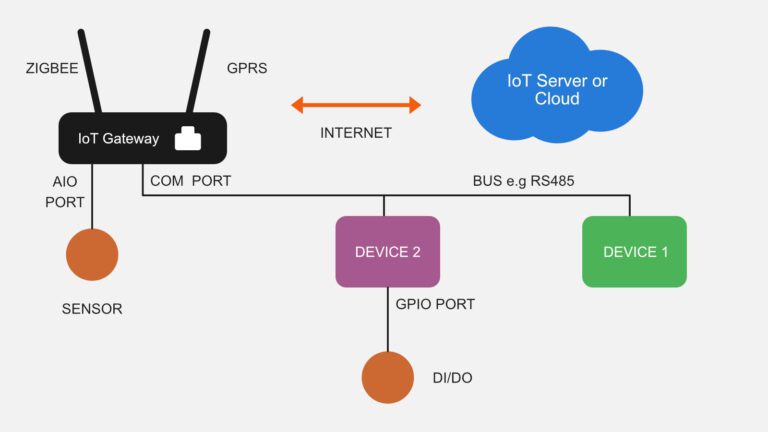The following are referred to as overall vibration measurements:
- Displacement (Peak to Peak)
- Velocity (Peak)
- Acceleration (True Peak)
- High-Frequency Accelerations (RMS)
RMS value is defined as the square root of means of squares of instantaneous values.
Peak (Derived Peak) = √2 x RMS . The Derived Peak is usually referred to as Peak.
True Peak is the maximum value attained by during one cycle of vibration waveform is called its True Peak value.
Peak to Peak is the difference between the maximum positive and the maximum negative amplitudes of a waveform.
Displacement – Is derived from the acceleration data or directly measured using an LVDT or laser probe. It is the total distance traveled by a vibrating body from one extreme to the other. Displacement is a measure of mechanical stress. It is measured in mills. Mills is 1/1000 of an inch.
Velocity – Is derived from the acceleration data and is measured in m/s or inch/sec. It is the rate of change of displacement. Velocity is a measure of mechanical fatigue.
Acceleration – Is measured using an accelerometer and is measured in g’s (g=9.8 m/s2). It is the rate of change of velocity and represents the forces experienced by the equipment.
High-Frequency Accelerations or Energy – Is the acceleration RMS or the peak in the filtered high-frequency band ( Usually 5 kHz to 50 kHz band).
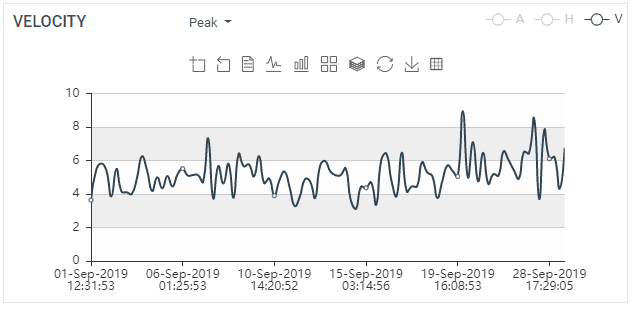
Why are they important?
These are called overall measurement as they provide an overall single value of measurement instead of a spectrum. Overall measurements can be used for identifying a developing fault in a piece of equipment. Overall measurements can be trended over time to make out the trend in machine health. Overall measurements have their own limitation and it is not possible to identify the specific fault as it requires identifying values at specific frequency.
What are the 3 important parameters for vibration measurement?
How to choose the right overall measurement metrics? You must understand the use and limitations of each overall measurement before you start using them.
| Overall Measurement | Application | Where to use? |
|---|---|---|
| Displacement Peak to Peak | Used for analyzing stress-related defects occurring in orders of rotating frequency. | Displacement is a good measure for low-frequency vibration and is not suited for high-frequency vibration. It can be used for analyzing frequencies of less than 20Hz. It can be used on equipment running up to 1200 rpm. |
| Velocity Peak | Used for analyzing fatigue-related defects occurring in orders of rotating frequency. | Velocity is a good measure for medium frequency vibration. It can be used in the 10Hz (600 CPM) to 1KHz (60,000 CPM) frequency range. It can be used on equipment running from 1200 to 3600 rpm. |
| Acceleration True Peak or High-Frequency Accelerations RMS | Used for analyzing force related defects occurring in the high-frequency band. | Acceleration is a good measure of high-frequency vibration. It can be used for analyzing frequencies of more than 1KHz (60,000 CPM). It can be used for identifying bearing, cavitation and lubrication issues. |
Measure Vibration Data with AI
What defects can you identify with them?
Machine faults lie in different frequency bands. Since different overall measurements are suited for different frequency bands we must select the overall measurement that is sensitive to the vibration frequency the machine will produce. You might have to use a combination of them to cover the entire frequency range.
| Defect | Frequency | Overall Measurement |
| Misalignment, looseness, rubbing, imbalance and belt defects. | 1.5 to 2.5 times the RPM | Displacement or Velocity based on RPM on the machine. |
| Misalignment and looseness | 2.5 to 4.5 times the RPM | Displacement or Velocity based on RPM on the machine. |
| Late-stage bearing fault harmonics and electrical issues | 4.5 to 50 times the RPM | Acceleration An increasing trend in Acceleration true peak is an indication of late-stage bearing defect. Accelerations over 7g (ball bearing) and 12g (roller bearing) are a strong indicator of the defective bearing. |
| Early-stage bearing defects | 1 kHz to 20 kHz | High-Frequency Acceleration |

In most industries equipment is operating at rpm’s between 1200 to 3600. This makes Peak (Derived Peak) Velocity the preferred overall measurement to measure vibration severity at rotating frequency and orders of rotating frequency. Acceleration True peak is a good overall measurement to identify late-stage bearing defects. While High-frequency acceleration is a good indicator of the early-stage bearing defect.
It is important that you use something like ioEYE Predict and our vibration sensor to monitor and trend these overall measurements at regular intervals. You can then monitor the trends over time and set alerts thresholds on these overall measurement parameters. Trending is more important in the case of machines that normally produce high accelerations, like screw compressors. In such cases, a change in trend is more important to observe than absolute values.
Trending is also important in cases of unbalanced machines as in this case unbalance will modulate the vibration and bearing race defect frequencies will not show up. In this case, the upward trends of High-Frequency acceleration and True Peak acceleration will be indicative of the bearing defects.
Only looking at overall measurements can at times mislead you. You should only use them as an indication of fault and carry out detailed spectrum measurements and analysis to confirm your findings. Example peak velocity can mislead you to believe that the vibration level is high but you should always validate such cases with a velocity spectrum. The frequency of the peak velocity in the spectrum can help you distinguish between an actual or a false alert. If you cannot capture the spectrum you should at least measure Velocity True Peak. If True Peak is very high as compared to the Peak it means the first three harmonics are very prominent.
Overall measurements can provide you the indication that there is some problem and that further analysis is required. Using them alone without further detailed vibration analysis can lead to a lot of incorrect diagnoses.
